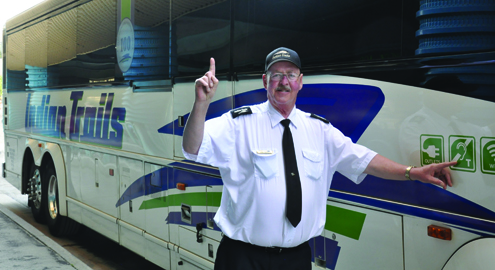

Indian Trails and MDOT bring a proven technology to hearing-impaired bus riders
By David Hubbard
Family-owned Indian Trails, Inc., with operations in Owosso, Kalamazoo and Romulus, MI, enjoys a 100-year history of innovation. The company says it was the first motorcoach operation to install two-way radios, video monitors, stereo sound systems and Wi-Fi on a fleet of buses.
Over the summer Indian Trails teamed up with the Michigan Department of Transportation (MDOT) to install hearing loop technology on a fleet of 17 motorcoaches operating 34 scheduled routes throughout the upper and lower peninsulas. For tens of thousands of Michigan residents, the Indian Trails routes are the only means to connect with the national transportation network of airports, Amtrak and Greyhound.
“This is proven technology that represents an enormous improvement in the on-board experience of many of our passengers who are hard of hearing,” says Gordon Mackay, president of Indian Trails. “The cost was relatively low ― about $800 per bus ― and very little maintenance is needed. We would eventually like to see it installed in all of our motorcoaches and in all bus stations.”
Hearing Loop Systems, also based in Owosso, worked with Indian Trails on the install. Established in 2008 as a division of Ascom, Morrisville, NC, the company brings over 30 years of experience into installing audio/video systems for all types of commercial establishments and is the leading provider of loop systems. With the popularity and awareness of loops on the rise, the company is developing a network of certified installation companies across the United States to install its American built products.
“We are working together with audiologists, architects, consulting firms, and non-profit organizations across the country to promote and develop looped communities,” says Hearing Loop Systems President Todd Billin “Hearing Loop Systems is extremely excited about what Indian Trails has accomplished, and we just are passionate to teach others in the bus and coach industry about this technology.”
MDOT says it was very excited over this opportunity to provide state funds to allow Indian Trails to make hearing loops available on a portion of its fleet and two intercity bus stations. MDOT also installed hearing loops on a pilot basis at bus stations in Saginaw and Bay City.
According to Sharon Edgar, administrator, MDOT Office of Passenger Transportation, MDOT and Indian Trails share a commitment to increasing the accessibility of the state transportation system. At the same time, David G. Myers, a professor of psychology at Hope College, Holland, MI, has hearing loss and is one of the nation’s foremost advocates for hearing loops, and runs the website www.hearingloop.org.
“I’m quite sure this is the first American bus line with hearing loops,” Myers says. “The Indian Trails and MDOT installation of hearing loops on inter-city buses is a model of transportation accessibility for the entire country.”
What is a hearing loop?
Based on proven technology dating back to the 1950s, a hearing loop is essentially a wire attached to the sound source that extends around a space such as a living room, auditorium, church, airport terminal or bus interior. The wiring enables hearing aids equipped with telecoils — tiny coils of copper wire — to amplify a single source of sound such as a telephone, television or PA system instead of amplifying all sounds as ordinary hearing aids do.
The hearing loop electromagnetically transmits those sounds from the PA system directly into to the telecoil in a hearing aid, allowing hearing-impaired passengers to clearly hear the announcements while screening out surrounding noises. Nearly 70 percent of hearing aids in the U.S. are already equipped with telecoils.

The inside of a bus, train, airplane or transportation terminal can be so noisy that even passengers with ordinary hearing aids cannot separate important public announcements from the sound of a crowd, a crying baby, background music or nearby conversations.
“Because hearing aids work far better when a hearing loop is available, and because hearing loops are common in Great Britain, Scandinavia, Australia and New Zealand, I am often asked why more hearing loops are not being installed in the U.S.,” Myers says. “The answer is that our federal disability laws require most public facilities with 50 or more seats to provide unspecified assistive listening devices, which they tend to do by letting visitors borrow earphones and pocket–size receivers that tune into FM broadcast signals or infrared waves.”
He says most people with hearing loss won’t bother with those.
“On the other hand, if a hearing loop is available, it’s easy for people to just flip a switch on their hearing aids and change to T-mode to get sound from the telecoil rather than through the normal microphone mode,” says Meyers. “Moreover, rather than providing the same generic headset sound to everyone, hearing aids customize hearing loop sound output to suit one’s peculiar hearing needs.”
The Hearing Loss Association of America (HLAA), Bethesda, MD, the country’s leading membership and advocacy organization for people with hearing loss, provides assistance and resources for individuals and families to learn how to adjust to living with hearing loss.
According to HLAA Executive Director Brenda Battat, the organization fully supports hearing loop technology for the independence it invites.
“Hearing loops offer seamless access to facilities and services that would normally cause a hearing-impaired person a lot of frustration,” she says. “While emphasis over the last three years has been on assisted technology such as FM frequency and infrared, which require hand-held receivers and other apparatuses, hearing loops are not as obtrusive. Pushing a button on a hearing aid is a lot easier.”
She says HLAA is based on self-help; that given enough information and resources, people with hearing loss can deal with a challenge and go out and make changes on their own.
“We give Indian Trails high praise for responding to the needs of our members, and essentially stepping up as the leader in their industry,” says Battat. “Hopefully others will follow.” BR
